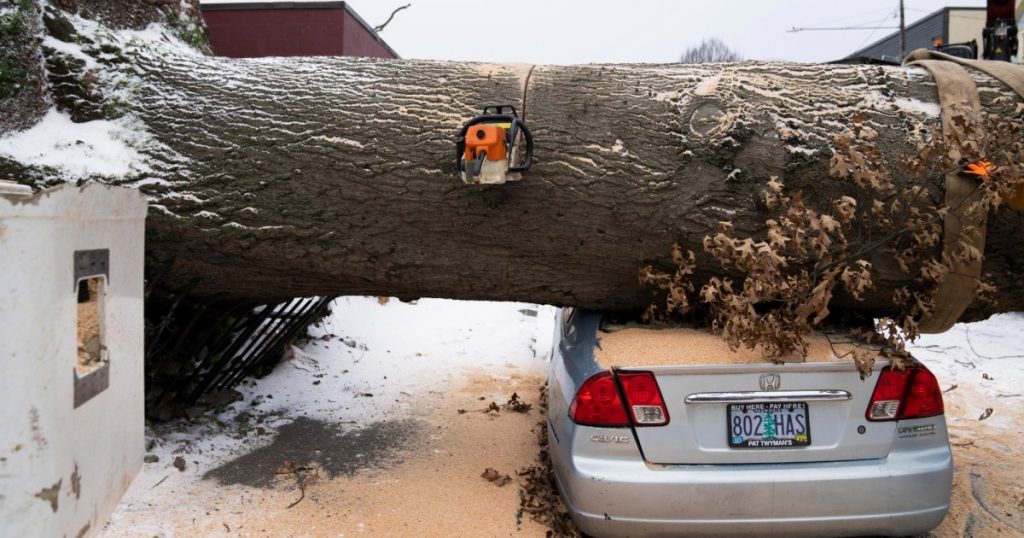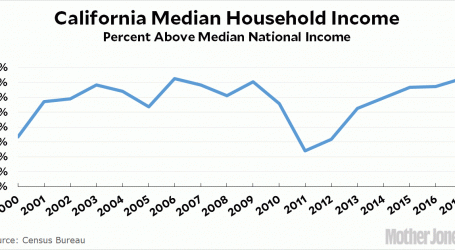Climate Change Caused the Storms. Our Failing Infrastructure Made Them Lethal.
A downed tree in Portland, OR on Jan. 13, 2024.Jenny Kane/AP
When snow hit Nashville this January, residents were almost cheerful as they noted the rare occurrence. A local musician posted a video, singing in the snow, with the caption “I thought when we moved South we did not have to worry about snow…too hot to be cold!” But the upbeat demeanor in Music City dissipated as conditions became treacherous and accidents started to be reported. Then the power went out as equipment failed in the cold. Nashville residents weren’t alone in their troubles. The multi-week winter storm blast knocked out power for more than 750,000 Americans. Potable water was inaccessible in over 75 municipalities across both states, including cities such as Springfield, Oregon, where more than 60,000 residents were forced to boil their water for four days after pipes exploded and water infrastructure was damaged in the storm. Even as roads have opened up, the refreezing of water on streets and unexpected disasters like sinkholes keep travel treacherous. Over 70 Americans so far have been reported dead. Most of those deaths are emblematic of structural failures—collisions on icy roads, hypothermia from heat and power loss, and tree damage—that improved infrastructure and city planning could have mitigated. Experts have been quick to call out the role of climate change in the storm’s intensity. Due to a disrupted polar vortex, exacerbated by global warming, the polar jet stream is more likely to bring intense cold to certain locations. Paradoxically, climate scientist Jennifer Francis told the Associated Press, “When the Arctic is off-the-charts warm (like now), we’re more likely to see frigid cold invade places like Texas that are ill-equipped to deal with it.” Some states, like Oregon and Tennessee, are also ill-equipped to deal—and they’re feeling it. While eastern parts of Oregon have historically seen regular snowfall in the double digits, the Willamette Valley (where most of Oregon’s damage was sustained) sees, like Tennessee, five inches of snowfall in a typical year. The average temperature in both regions never drops below freezing. It’s not surprising that states used to limited snow have limited snow infrastructure, explains Josh Bruce, associate director for applied research at the University of Oregon’s School of Planning. “We’re not going to have lots of snowplows and de-icers, because we don’t see these events particularly often,” he said.
But the problem isn’t two states underprepared for a storm. US infrastructure as a whole has consistently not been up to the task for regular use, let alone climate crisis–induced exacerbation. The same issues have been seen in inverse: States like Massachusetts, known for its snow resiliency, face growing wildfire risk—a hazard Oregon has long been prepared for. “Nationally, in terms of critical infrastructure in particular, the US doesn’t grade particularly well,” Bruce says, pointing to years of public works and engineering assessments. Joseph Schofer, professor emeritus of civil and environmental engineering at Northwestern University and host of The Infrastructure Show, a podcast, agrees that our infrastructure is “due for an update.” He told me that infrastructure is designed for a “certain range” of stress and demand. “When conditions exceed, we’re not prepared for it,” Schoefer explains. “Now, the assaults have changed and they’re much greater.” Schoefer says that lack of preparation was a choice. “We didn’t design for that. We didn’t expect it. Should we have expected it? Historical evidence did not suggest it, but the trend line did.” Bruce encouraged me to look beyond the current storm cycle to the systems behind it. “In this event, electricity was a big deal,” Bruce said. “A lot of people lost power, and if the only thing that they’re reliant on is electricity, things kind of slow down and grind and grind to a halt.” The snowstorm showed that Oregon could have improved canopy management, which would have reduced power outages. But it also showed that the power grid didn’t have adequate backups when its lines were damaged, which could happen in a variety of disasters—including ones more common to the region. In 2022, Oregon’s legislature passed a bill investing $220 million in fire preparedness, but the strategies focused on wildfire-specific responses like risk mapping and prescribed burns. “Everybody’s going to talk about the winter storm and forget the context: how does this event fit in with the wildfires that we had in 2020? How do we think about flooding that may occur later this year?” Bruce asks. In 2020, when Oregon faced a particularly bad wildfire season, the Oregonian reported that 50,000 residents lost power. Four years later, in the latest winter storm, grid failures left 200,000 without power. In February 2022, 132,000 people in Tennessee lost power due to a winter storm. The year before, 260,000 households in the state lost potable water also due to winter weather. “People’s attention spans are really short.” Bruce says. Across the US, energy specialists warn that power grids aren’t prepared for this weather—especially amid transitions to green power. “There’s a fundamental difference between the gas and electric systems,” Ted Thomas, a former state energy regulator in Arkansas, told EnergyWire, referring to the fact that pipelines are built “incrementally by contract,” in contrast with the widespread planning of a power grid. “When they rub like this and we’re relying on gas in extreme weather, it creates a challenging situation.” Grid experts are brainstorming to create power stations that are resilient to new disasters, especially after all power plants in New York state came dangerously close to losing power in 2022’s Winter Storm Elliot. “You need to build a grid that’s bigger than the weather,” another expert told EnergyWire.
The problem, though, is the US’ systematic delays in infrastructure investment. “We’re not investing on an ongoing basis,” Schofer says. “We’re not fixing roofs when there’s a growing problem, every 10 years or something like that. We’re waiting every 40 years, [until] the roof was leaking, and now saying, ‘Oh my God, I need a lot of money.’” Even monumental investments like the 2021 bipartisan infrastructure deal barely scrape the surface of resources needed. The bill, which includes more than $343 billion for major projects like coastal restoration and road improvements, is not entirely the boon it seems. “When you read the fine print, only half is new investments and the rest is routine investments.” While it’s a good start, Schofer told me, “it’s a fraction of what we need.” The country’s disinvestment in infrastructure has outsized effects on some. “More vulnerable populations tend to see a greater impact,” Bruce explains. Research shows that people dependent on electrically powered medical devices were disproportionately affected by winter storm outages. Communities of color and low-income communities have disproportionately poor infrastructure due to systematic disinvestment, meaning they are more at risk when storms hit. “Communities that don’t have a political voice tend to either be ignored or adversely impacted by infrastructure decisions, whether that’s highways being put through low-income neighborhoods or disinvestment in certain areas. That’s the reality of our culture and society,” Bruce says. Bruce encourages legislators and planners to take a multi-hazard approach. “Whether it’s an earthquake, a flood, a landslide, a windstorm, a drought, a winter storm,” Bruce says, “the more diversity in those systems the better”—both in terms of having systems that work for multiple events and maintaining backups. Bruce recommends that states invest in microgrids, self-sufficient local power grids that will make the overall grid more redundant. That could look like installing solar panels and battery storage at critical facilities like hospitals and fire stations, so they won’t fail when a wider grid goes down. Counterintuitively, some responses to extreme weather require fossil fuel dependence. Across Oregon, Bruce explains, “There’s been activist attempts to try and have no natural gas installed in residences. A lot of people are saying ‘No fossil fuels ever at any time.’ Personally, I don’t think that is realistic—at least not right now, until we have better sources of redundant power.” Schofer agrees that climate-resilient infrastructure and decarbonization are not always aligned. “[Green energy] is another bucket to put your money in. It’s another demand on resources. How much can we afford to do? Another way to look at it is to say, ‘If I have to rebuild, can I do this in a greener way?’” But Bruce cautions against an uncritical look at some plans for green energy. “Batteries for electric vehicles or battery walls currently require some metals that are kind of nasty. Extracting those impacts tribal communities and natural areas. All of this is about trade-offs.” Three weeks after the latest storm, both Tennessee and Oregon are still rebuilding, with encouraging bills on the docket. The newest draft of Tennessee’s Transportation Modernization Act promises to drastically reduce the states’ billions of dollars in road repair bills, but not eliminate them. In Oregon, many are supportive of a bill to fund housing infrastructure, both to combat homelessness and improve climate resiliency. But as weather warms and the next disaster looms, the question remains: is it enough?





